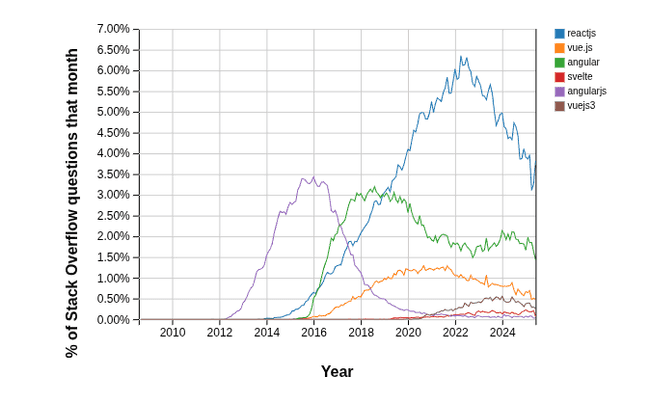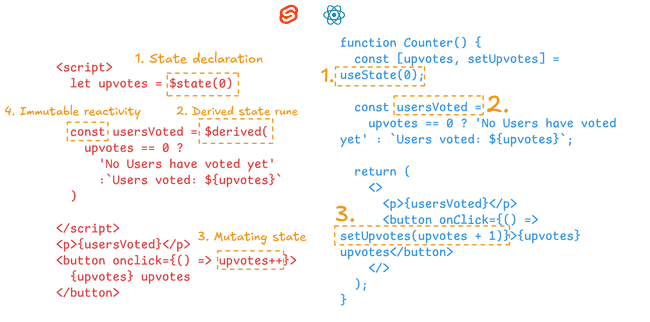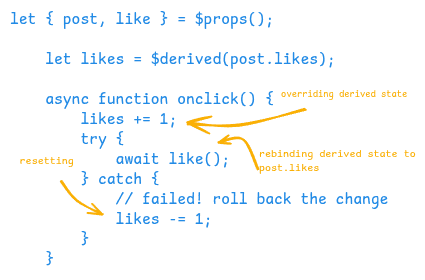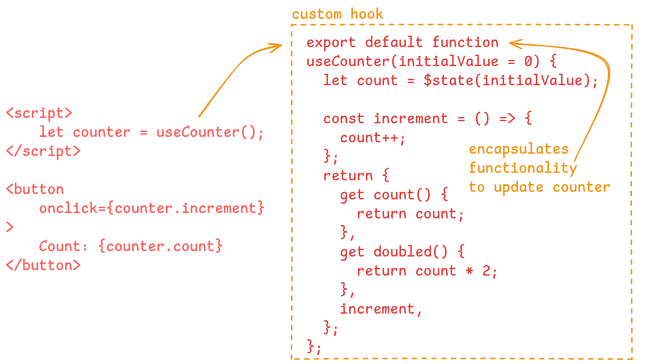Guide to svelte state for react dummies
Are you a legacy React developer?
Have you heard of the chronicles of a once-mystical creature 👾 known as class based components in React?
After spending so long exclusively in the React ecosystem — with only brief forays into Vue.js and Angular — I almost feel confined, as if under house arrest. It's as if React has become a pandemic and developers its captive patients. Attempting to leave this ecosystem — which has admittedly served me well in terms of developer satisfaction and community standards reminiscent of Golang — feels like swimming against the current of global popularity trends.

Wait, let's pause for a moment… we're drifting from the topic. This isn't an angry rant about why you should abandon React and sail off to svelte land—I'll save those opinions for another day. While I'm not a svelte advocate (having barely dipped my toes in it), there is some evidence in svelte's blog and a single Hacker News thread about the modest runtime performance benefits of svelte over React —though a 95% decrease in bundle size is nothing to laugh at.

The purpose of this article is to provide an exhaustive guide on the dos, don'ts, and gotchas of local component-level state management in svelte. I was recently influenced by the yellow house — while the column explores Van Gogh's artwork and its psychological implications — my takeaways from it gave me the notion (also, the editor of choice for writing this article) that drawing parallels from our experiences is the most effective way of learning and moving forward.

Defining the scope
As much as I'd like to cover the intricacies of event handling, idiomatic design patterns, and dive into the internals of svelte, these topics are already well-documented in svelte's docs for those willing to take a deep dive. Instead, we'll focus our exploration on answering these key questions:
- How does state management work 💪 and what are runes?
- ❓ How does reactivity work?
- What causes dependencies of state to update?
- 🪝 How to make custom
react-likehooks in svelte?
Let's get started 🚀
Let’s Rune your day
Runes constitute the primary tools for state management in svelte. To quote from the official svelte docs:
If you think of svelte as a language, runes are part of the syntax — they are keywords.
Our exploration will be limited to the following set of runes: $state, $derived and $effect. Starting with a snippet of code, we have the same functionality implemented in svelte and React. The annotations highlight the 1:1 mapping between syntax in the two libraries (Even though svelte is a framework, we’ll refer to it as a library for the purposes of this article).
 We’ll break down the code piece by piece to highlight the key differences and potential gotchas, so you’re not caught off guard at work.
We’ll break down the code piece by piece to highlight the key differences and potential gotchas, so you’re not caught off guard at work.
Runes were introduced in v5 — the latest major version at the time of writing this article. All
state can be safely migrated to use runes, with the added benefit of improved performance. The
official migration guide is available here.
State reactivity using proxies
In Fig. 1, we declare and initialize a local store using $state(0). Under the hood, svelte sets up a proxy to enable reactivity. In simple terms, proxy intercepts any read or write operations on the state object. The state is consumed in a way that feels similar to React, although updating state in svelte often requires a slight mental shift to get used to.
In svelte, state is mutable, irrespective of it's value being a primitive or an object. This is demonstrated in Fig. 1 (Point 3) using upvotes++. This mutation updates the state and triggers a UI re-render in the next animation frame — similar to React’s setState(upvotes + 1).
Sweet! Let’s move on to other syntax features.
Deprecating $: in favor of $derived & $effect
In svelte, any variables or functions defined outside of runes are declared and run exactly once when the component is initialized.
const upvotes = $state({
count: 0,
completed: false,
});
let derivedDoubled = $derived(upvotes.count * 2);
let doubled = upvotes.count;
$effect(() => {
let timeout = setInterval(() => {
console.log(upvotes.count);
});
return () => clearInterval(timeout);
});There are a few points to note from the snippet:
$effect— acts as a drop-in replacement foruseEffect, with runtime fine-grained dependency tracking.derivedDoubleduses$derived— it automatically updates based on variables referenced in the expressionupvotes.count * 2. According to the svelte docs, it updates synchronously using push-pull reactivity, ensuring that any function accessing derived state receives consistent values in sync with its dependencies.doubled— remains unchanged whenupvotes.countupdates, behaving similarly to React’suseRef.
ℹ️ Use derived.by(fn) for more complex
logic instead of the shorthand derived(expression).
Reactivity is fine-grained
const upvotes = $state({
count: 0,
completed: false
})
$effect(() => {
console.log(upvotes.completed ? `Voting has completed`: 'Voting not completed')
})
<button onclick={() => upvotes.count++}>
clicks: {upvotes.count}
</button>In the example above, we’ve modified the upvotes $state from number to object . To follow :
- We’re incrementing the
countproperty. - Using
$effectto log whether the voting has completed — similar touseEffectin react.
Since only upvotes.completed is consumed in the $effect block, it is not executed if upvotes.count is updated. This check is dynamically done at runtime, similar to useEffect. This is called key level granularity.
useEffect(() => {
console.log(upvotes.completed ? `Voting has completed` : 'Voting not completed');
}, [upvotes.completed]);Key Takeaways:
$effectobserves the reactive signals ($state,$derived, etc.) while executing its expression. That means dependencies are dynamically detected during the function call—not inferred during build.- Prevent unncessary re-renders — The child components consuming
upvotes.completedwill not be re-rendered due to shallow comparison of props.
React offers better visibility into reactive statement while svelte works for the user with cleaner syntax and implicitly takes care of the dependencies.
ℹ️ Svelte optimizes away redundant assignments such as upvotes.count = upvotes.count or
upvotes.count += 0 will invalidate state updates.
Synchronous state updates
Task — We want to execute fetchCountLogs immediately on update of upvotes.counts . In React, we couldn’t directly use the next state due to asynchronous updates. Therefore, we are bound to create a new variable called newUpvotes which needs to be referenced everywhere if we were to use the updated value of upvotes.count.

svelte takes a different approach, decoupling state updates from batched DOM re-renders. This allows fetchCountLogs to run immediately after incrementing the value of upvotes.count , consuming the latest value of the state.
Overriding immutable reactivity in $derived
Coming to the fourth point mentioned in Fig. 1, derived state is rarely mutated manually and therefore declared as a const in 99% of usecases. A rare case, mentioned in svelte docs, displays the case of optimistic UI updates, where we want to override $derived manually, hence declaring it as let.

While it helps make the website feel snappy, it should be used in rare instances and in features which aren’t critical to write failures. For Example, liking a video on youtube can have optimistic updates, since the count is an estimate to begin with while commenting on the post could only be shown as sent when the server request is marked completed.
An alternative to custom react-like hooks
By now, we already have all the tools required for creating custom hooks using runes. It’s a straightforward vanilla solution with an uncanny resemblance to react hooks syntax. I’ve implemented a usePrevious hook which tracks the previous value of the state variable using runes.

Working version for the above example is present here. There’s a bunch of commonly used hooks implemented on this website in both javascript & typescript . Happy hunting :)
It is worth noticing that runes can only be used in files with extension svelte.{(ts, js)} .
What lies ahead?
Despite having discussed exhaustively about the properties of component state management and reactivity, there’s certain topics necessary to make your life easier working with svelte:
- Managing global state using svelte stores (next part in the series, hopefully)
- Updating parent state from child components leveraging
$props&$bindable - Bypassing deep reactivity using
$state.raw&$state.snapshot - Handling direct DOM mutations based on state updates using tick
- Resetting component and it’s state using key blocks
I hope this article helped you understand the basics of runes and state management—and instilled some confidence to support your journey toward becoming a svelte wizard.
Feel free to comment on what you liked, disliked or hated. Or reach out directly on Twitter.
Footnotes
- Vladimir Klepov Highly recommend his deep dive into svelte reactivity
- Svelte Docs to get lost in the rabit hole of the framework
- MDN Docs It's more than just documentation
- XKCD Comics While Empericism was more apt for the article, one of my favorites is a take on the fragile nature of proprietary projects
- Shymanta D, Dyutimitra S. The Yellow House is one of numerous psychological case studies, distinguished by its clean and concise presentation
- UseRunes - Explore custom hooks